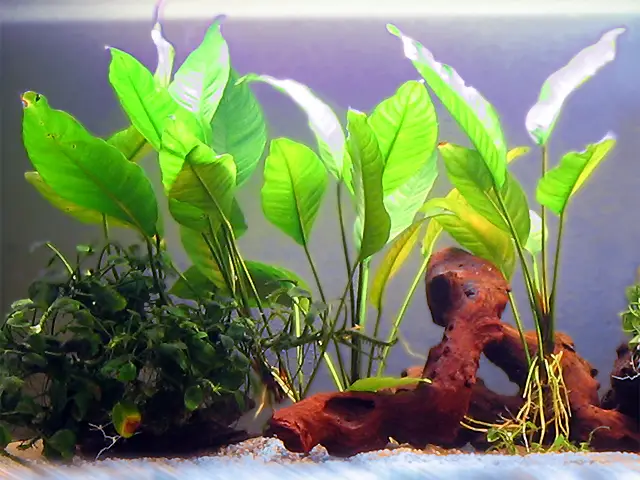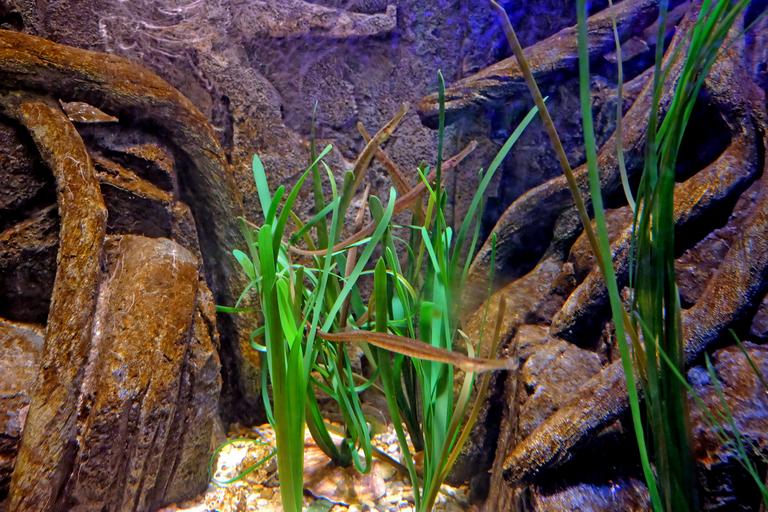Anubias, a semi-aquatic flowering plant commonly used in freshwater aquarium tanks, is a popular choice in the fishkeeping community. It may seem surprising if you’ve only ever seen anubias in an aquarium, but this plant can actually grow with their leaves out of water.
Anubias can grow out of water, and actually thrives when it is emerged. To do so, you’ll need to develop the right light conditions, water requirements, and growing media.
As it turns out, anubias are more than just a great starter plant. They can thrive in a variety of conditions. The rest of this article will discuss how anubias grow out of water and how it’s best to plant them.
Does Anubias Need to Be Fully Submerged?
Anubias does not need to be fully submerged to grow. In fact, anubias grows better when it’s emerged, which simply means that the leaves are sticking up out of the water. As such, anubias can work wonderfully in a terrarium under the right conditions.
The tricky part of growing your anubias emerged is that the plant requires a lot of moisture to thrive. This moisture is obviously easily accessible inside a closed environment like an aquarium, but if you don’t give the leaves of your anubias enough moisture or humidity, the leaves will die off.
As such, if you have a closed lid tank, your anubias should thrive being emerged. That is, with the leaves above the surface of the water. As the water evaporates, it clings to the lid of the tank, creating a perfect humid environment for the anubias.
It’s not a good idea to have your anubias emerged if you have an open lid. Humans prefer a much less humid environment than plants, and the humidity in your aquarium tank room isn’t going to be suitable for your anubias to grow properly or look aesthetically pleasing.
Can Anubias Grow on Soil?
Anubias cannot grow well on soil out of the water. It’s simply not going to work. Anubias prefer to ‘cling’ to rocks or driftwood. If the stolon, or runner if you prefer, is submerged, the plant will die.
In contrast to many other aquarium plants, anubias generally prefer lesser light and thrive in shadier environments. Moreover, as mentioned before, they require a humid environment to grow out of water.
All of these factors make the traditional life of a potted plant a poor fit for anubias. The leaves will dry out and die due to light exposure and lack of moisture, and the stolon will be suffocated by the soil.
In an aquarium, however, you can certainly anchor or plant the anubias roots in soil in an aquarium, but you should ensure that the rhizomes aren’t buried with the root. Anubias are root feeders, but getting them to affix to the soil can be difficult. To do so, you’ll need to take some stones or other decorations and weigh down your anubias so that it stays put.
Once again, avoid burying the stolon so that you don’t kill the plant. After about a month, you’ll be able to remove the rocks, and the anubias should have planted itself.
Of course, if you just want to take the easier route, it’s much simpler (and perfectly acceptable) to attach your anubias to hardscape like a stone or bogwood.
How Long Can Anubias Nana Be Out of Water?
If you need to take your anubias nana out of a tank for any reason like a deep clean or redecorating, then your plants will be perfectly fine for about half an hour out of the water. If you suspect you’ll be any longer than that or you just want to play it safe, then it’s prudent to put your anubias carefully into a moist Ziplock bag.
As you’ll recall, anubias have very high humidity requirements, so enclosing them in a space with high humidity will help them manage better if you need to take them out of your tank for any reason.
Caring for Anubias Emerged
If you’re planning on growing your anubias emerged, there are several factors you should consider that will make the process a lot easier and likely more successful.
Light
Anubias aren’t picky when it comes to their light requirements, which is part of what makes them ideal for a lot of beginner aquariums. In fact, your biggest risk when it comes to light for your anubias is overdoing it.
You want to make sure that the leaves on the anubias aren’t turning yellow and dying off. If so, then it’s likely that you need to reduce the amount or intensity of light your anubias is getting.
Media
It’s important that you get an appropriate media for your anubias to grow in. Getting a substrate designed for aquatic plants is important if you’re wanting to plant your anubias emerged. Sand or a fine grain gravel will do perfectly. You could also attach it to a rock or wood with a tank-safe superglue or firmly tie it down with thread.
Anubias will manage just fine floating, but it’s not as ideal.
Water
Different species of anubias vary in their requirements, but you should aim for a temperature from 73 to 80 Fahrenheit (23 to 27 degrees Celsius). The pH should range from 6.0-8.0. As a general rule, if your water parameters are ideal for your aquatic fish to survive, then your anubias will manage just fine.
Feeding
Anubias aren’t fast-growing and don’t need any special feeding requirements. Fertilizer can work to help balance out a nutritionally starved diet, but in general, you shouldn’t have to directly feed your anubias to keep it healthy.
Final Thoughts
Anubias are wonderfully hearty plants that can grow in a variety of conditions, but they can’t grow fully out of the water. They need a very moist environment to survive, so they can manage well if they’re emerged in a closed lid tank. This gives them the moisture requirements so that they can thrive in an aquarium setting.



